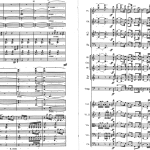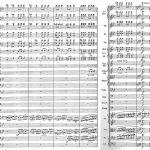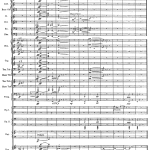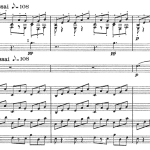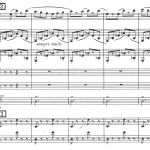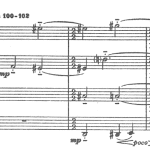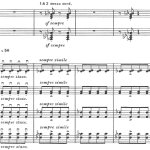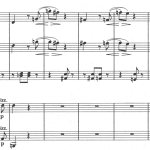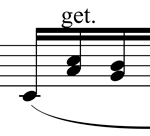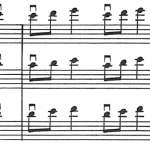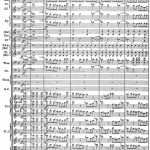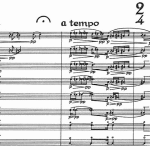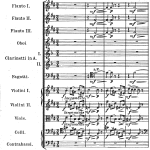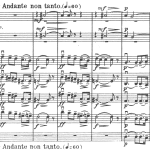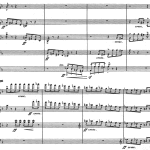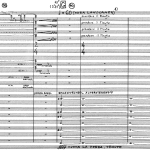The term orchestration generally refers to the process of transferring musical elements, ideas and concepts to the orchestral medium. Terms such as “arrangement” or “adaptation” are also used in connection with scoring for orchestra. But as mentioned earlier, the word “translate” may appear particularly telling, because it implies that the way in which something is said changes (into another language), while what is said, the actual content, is preserved with as few changes as possible. The fact that composers often regard such a translation as an integral part of the composing process does not negate the line of thought centering around essence and appearance introduced in the previous chapter. Orchestration is not a phenomenon that exists an sich, in itself – something has to be orchestrated!
The term “translation,” on the other hand, denoting the process involved in the act of orchestrating, does point to the symbiotic relationship between composing and orchestrating experienced by many composers: two sides of the same coin, neither one more important than the other. In fact, it is hardly ever a simple matter of either/or. We know that composers like Mahler and Strauss often wrote their orchestral music directly into short score. Yet “translation” (in the sense of transcribing) is a common method by which the craft of instrumentation is taught, often using piano or chamber music as the basis for orchestration exercises. And indeed, history has shown that some of the greatest orchestrators worked for long periods on the orchestration of a new work whose actual composition, one must assume, was basically concluded. This is generally true of works such as Mahler’s symphonies, Schoenberg’s Gurrelieder and Stravinsky’s Le sacre and Les noces, and for Ravel it was the rule rather than the exception.
To regard orchestration as a straightforward process designed to drape the musical material in different colors and to organize and distribute musical elements among the various instruments, would be a gross simplification. Tone colors and instrumental characteristics strengthen or perhaps even condition the way in which we experience similarity and contrast, affecting what we consider to be important or unimportant, background or foreground, etc., while faceless or vaguely defined textures would weaken our experience of form and continuity. Composing for orchestra means exploiting the idiomatic qualities of an orchestra – its wealth of specific possibilities of sound, tone color and instrumental characteristics – to condense, intensify or amplify all the different elements of the music. And surely this must be how the composers mentioned above understood the craft of orchestration. No doubt, the choice of specific instruments and sounds largely took place in advance as part of the compositional process. Whether the exact design of an orchestral passage was motivated by compositional considerations or resulted mostly from instrumental ideas is impossible to assess, and hardly significant.
The basic elements of music – melody, harmony, rhythm and timbre – are also the core elements of orchestration. But in the process of clarifying and intensifying music through the medium of the orchestra, other musical elements may come to play an equally important role. In music written for one or a few instruments, a myriad of markings (dynamics, phrasing, articulation, etc.) are entirely left to the discretion of the performer(s), while the orchestral medium allows the composer to clarify, amplify and control aspects of musical expression that would otherwise be subject to individual interpretation.
An indication such as crescendo can be interpreted and realized in different ways by different performers. An orchestrated crescendo – a crescendo built into the orchestration – is independent of interpretation. It inevitably results from the specifics of the score and can neither be overlooked, ignored nor suppressed, as it represents irrefutable evidence (cf. the Berg example fig. 13 · Essence and Appearance – Intent and Realization) of the composer’s intention.
Figure 14 · Beethoven, Symphony No. 9, 1st movement, m. 6
This is a historical crescendo, among the most dramatic and famous in classical music. Beethoven systematically adds more and more instruments.
Figure 15 · Berlioz, Harold en Italie, number 53, m. 17
Berlioz rarely indicates “crescendo” alone, but generally orchestrates the increase in volume, one of the composer’s countless innovations. In the above example, the volume builds up quite methodically (as does the intensity, when the bassoons jump up an octave in measure two) on every beat (alla breve). Clearly, this orchestration will result in a crescendo. It goes without saying that the same principle applies to an orchestrated diminuendo, a situation that – somewhat surprisingly – occurs far less frequently in the symphonic literature. Haydn’s so-called “Farewell Symphony” (No. 45, F sharp minor, 1772) is a famous example of a straightforward diminuendo. During the final movement, the musicians simply leave the concert stage one by one.
The following is an example of an effectively orchestrated diminuendo from The Planets by Gustav Holst.
Figure 16 · The Planets, “Uranus,” number IX
To claim that the idiomatic use of an orchestra requires all dynamics (in the broadest sense) to be orchestrated, would overstate the point only slightly. An increase in volume implies more (or louder) instruments, a decrease in volume calls for the opposite. This underlines the extended concept of orchestration formulated here: practically all aspects of the music – dynamics, articulation, phrasing, sound character, intensity, reverberation, register, and many more, can be refined, highlighted, clarified and reinforced by means of instrumentation. A good example is articulation, an area left to the discretion of the player or conductor, and a field in which opinions on the correct execution of certain symbols or markings can differ widely among musicians. But rather than depending on history, local traditions, different playing styles or personal taste, an articulation can be indelibly integrated into the instrumentation by purely technical means, yet another principle that commonly occurs in idiomatic orchestrations (cf. the chapter on Articulation). The Prokofiev example below results in an unusually characteristic and sonorous staccato. Note that the clarinets are marked mp while the strings have p.
Figure 17 · Prokofiev, Violin Concerto No. 2, 2nd movement, m. 1
In the example below, Stravinsky achieves an articulation somewhere between staccato and legato. The two clarinets play identical notes, each with its own articulation.
Figure 18 · Stravinsky, Suite No. 1, “Napolitana,” number 3
Similarly, legato and pizzicato are often combined in the strings, and the combination of cello legato and double bass pizzicato goes back to the earliest classics. The result is an attack whose sound rings on, maybe best compared with the pluck of a harp string. For Stravinsky, this bell-like attack became somewhat of a signature sound that he used again and again, often in orchestrated form. Introducing a notational innovation of two apparently contradictory articulations, tenuto + staccato (⨪) indicates a sustained staccato.
Figure 19 · Stravinsky, In Memoriam Dylan Thomas (1954), Dirge-Canons, m 1
The following famous passage from Le sacre highlights the accents in the strings with tremendous effect.
Figure 20 · Stravinsky, Le sacre du printemps, number 13
A clear distinction between articulation and phrasing can hardly be made, but to some extent an orchestration can underline or highlight the musical rhetoric itself, such as the natural, subtle crescendo and diminuendo of a musical phrase, notes on strong beats, meter and pulse. In the example below, the ascending octave in the flute highlights the phrasing.
Figure 21 · Berlioz, Roméo et Juliette, Scène d´amour, m. 185
In his annotated publication of Berlioz’ textbook on orchestration, Richard Strauss points to a melody in his own Sinfonia Domestica, a perfect example of “forced,” i.e. orchestrated phrasing.
Figure 22 · Strauss, Sinfonia Domestica, number 8 (1. violin)
The nonchalant, dancing character of the theme emerges only if the repeated three-note motive maintains its identity in every reiteration, notably the subtly implied diminuendo and the short, non-accented endnote. Changing between down-bow and up-bow will blur the consistency of the pattern, as the endnote will alternately be bowed down and up. Bowed down-up every time is likely to render the endnote too heavy, because of the up-bow. Strauss suggests the solution above. If the marking is respected, the desired phrasing results inevitably.
Whether bowing should generally be considered part of the process of instrumentation is debatable – musicians and conductors usually regard bowing as a mere recommendation (acknowledging that string players tend to know more about bowing than most composers). But whenever a bowing mark is well motivated, it should be respected. (Strauss, a conductor of world acclaim, chose not to include these markings in his printed editions). A similar bowing can be seen in the example below.
Figure 23 · Stravinsky, Le sacre du printemps, 3 m. before number 54, section
Even aspects of the music that only occasionally – or to a very limited extent – lend themselves to the musicians’ influence, can actually be “orchestrated.” One example is resonance. If musicians perform in very dry acoustics in a hall with limited reverberation time, they will generally have to accept this as given. But the imitation of resonance in orchestrated form occurs frequently in the history of instrumentation, notably starting with Berlioz and beyond. Precisely orchestrated resonance is one of the many features Berlioz developed with pioneering imagination (this topic will be elaborated upon in the chapter about Reverberation, Echo, Resonance and Acoustic Reflection). The passage below from Berlioz’ Symphonie fantastique is just one of many, but music history is unlikely to exhibit another example of a comparably radical expansion of orchestral thinking.
Figure 24 · Berlioz, Symphonie fantastique, 11 m. before number 63
The descending sequence – ingeniously distributed among the string players – creates a timbral fabric that rings on in different ways in woodwinds and brass: as a pedal point in flutes, oboes and trumpets, and as partial doublings in the other instruments, allowing single notes in the sequence to ring on. Here the classical notion of part writing (or voice leading) has been completely abandoned. The simultaneous presence of simplicity (essentially there is just one unison line) and an utterly sophisticated wealth of detail are without parallel in the music of the time, demonstrating that this symphony, written by a 26 year old composer only three years after the death of Beethoven, indeed deserves the name “fantastic.”
With his “101 Strings Orchestra,” Anglo-Italian conductor Annunzio Mantovani (1905–80) developed orchestrated resonance into something akin to a brand (dubbed cascading strings). Following Berlioz’ model, the strings sustained the individual notes of a melody one after the other, obtaining an effect not unlike that of a huge echo-chamber, regardless of the acoustics of the actual hall. This topic will also be treated in more detail in the previously mentioned chapter.
Below a similar passage from Lutoslawski’s Livre pour orchestre.
Figure 25 · Lutoslawski, Livre pour orchestre, Chapter 1, m. 1
The opening of the last movement of Tchaikovsky’s 6th symphony (“Pathétique”) is a controversial example of what might be seen as “orchestrated expressivity.” The painfully passionate theme in the strings (marked lamentoso, lamenting) is scored in such a way, that the voices swap position between each chord. This is quite unusual, and Tchaikovsky’s intention is not immediately apparent. Perhaps the music was meant to be performed with 1st and 2nd violins placed on either side of the conductor (see Orchestra Size and Setting). Whatever Tchaikovsky’s motive may have been, it is clearly a matter of orchestration rather than part of the theme’s identity, for when it returns later in fortissimo, the voice leading is regular. In a piano reduction, the two passages would sound identical, of course …
Figure 26 · Tchaikovsky, Symphony No. 6 (“Pathétique”), 4th movement, m. 1
Figure 27 · Tchaikovsky, Symphony No. 6 (“Pathétique”), 4th movement, m. 90
This further underlines the fact that orchestral music – in spite of high fidelity and up-to-date sound technology – must be heard live. Orchestral effects that may not be particularly striking in a recording can at times make a great impact in the concert hall, where the sound is dispersed in a much more perceptible, almost tangible way[1].
These examples demonstrate the instrumentation of musical elements other than pitch, harmony, line or rhythm, and testify to the possibility of achieving specific expressive results solely through the orchestral medium, irrespective of individual interpretation. Furthermore, and in a wider sense, they show how orchestration often serves to clarify or simply “amplify” musical intent and expression. This may even involve the register of the music. Register, change of register, high sounds versus low sounds, are essential factors in all music. But instrumentation makes it possible to highlight a specific register. In the following passage by Benjamin Britten, the contrast between high and low is emphasized by the addition of staccato in the double basses and harmonics in the violas. Using only perfect unison doublings and avoiding octaves altogether (cf. the chapter on Unisono and Doubling), this entire unisono movement is an instructive example that also demonstrates the orchestration of dynamics and articulation.
Figure 28 · Britten, Variations on a Theme of Frank Bridge, number 21, m. 15
The following famous example from György Ligeti’s Atmosphères exploits the tremendous range of the orchestra to its fullest extent – the plunge from extreme highs to extreme lows creates an overwhelming effect (the violins are marked “ottava” and sound an octave higher than written).
Figure 29 · Ligeti, Atmosphères, m. 34
· · ·
Next · Chapter 3 · Segment Analysis
· · ·
[1]Throughout most of his life, the Romanian-born conductor Sergiu Celibidache fought a lonely battle against the technical reproduction of music and consistently rejected recording offers from the gramophone industry. He insisted that a musical performance contained a number of factors that can be brought to life only in acoustical space, i.e. in a hall. And that diffusion of sound in space, overtones, combination tones and other factors represent a subtle network of psychoacoustic phenomena that completely disappears when reproduced by means of microphones and loudspeakers.
